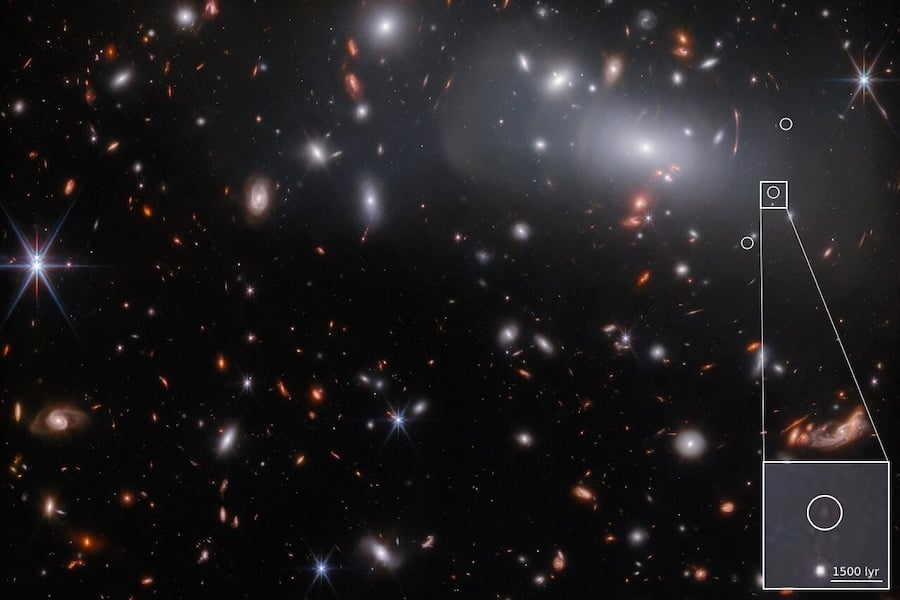(CN) — The James Webb Space Telescope has discovered an unusually stelliferous, miniature galaxy from the universe's infancy, according to a paper released Thursday in the academic journal Science.
Authored by a research team based out of the University of Minnesota in the Twin Cities, the paper claims the newly discovered tiny galaxy designated RX J2129-z95 dates to only 510 million years after the Big Bang. Known as z95 for short, it is located in the constellation of Aquarius and displays comparable levels of star formation to our own Milky Way despite being a thousand times smaller across.
Scientists estimate the Milky Way's radius at about 16,200 parsecs, compared to z95's radius of about 16.2 parsecs. Both bodies are estimated to produce about one to two solar masses annually, which may be equivalent to as many as seven new individual stars per year.
"This galaxy is about one thousand times smaller than the Milky Way, but it's producing stars at about the same rate," said Haley Williams, one of the paper's authors and a Ph.D candidate at the Minnesota Institute for Astrophysics, in an interview. "It's definitely a standout."
Patrick Kelly, another of the paper's authors and an assistant professor at the University of Minnesota's School of Physics and Astronomy, said the research team found z95 almost by accident. They were initially using Webb to study a nearby supernova, but wondered what else that region of space had to offer.
"We were trying to find other interesting things to look at, and this stood out," Kelly said.
Kelly said studying the miniature galaxy can shed light on how stars and galaxies formed in the hotter, denser early universe. He added that z95 may not even be a proper galaxy, as it seemed to lack an active galactic nucleus and its spectroscopic profile resembled smaller, dense groupings of stars known as globular clusters. For a size comparison, the Milky Way hosts more than 150 such clusters.
"One possibility is that this could be a baby globular cluster," Kelly said. "That means [its stars] formed out of the cloud of gas before the formation of a [galactic] disk."
The James Webb Telescope peered back in time more than 13 billion years to find z95, using imaging apparatuses that can detect about 10 times more light than the Hubble Telescope, primarily in the infrared spectrum. Webb's infrared cameras make it uniquely suited to study objects in deep spacetime because as the universe expands, light from more distant stars becomes redshifted - only visible in longer wavelengths, often into the infrared spectrum - due to the Doppler Effect.
But while Webb may be more suited to observing redshifted bodies than Hubble, the universe itself also helped Webb in finding z95. The paper's authors were able to conduct spectroscopic observations of the miniature galaxy in October 2022 due to a nearby galaxy cluster whose combined mass was so great that it bent light around it - a gravitational lens. This lensing effect created three separate images of z95, of which Kelly said the research team picked the brightest to study.
"That cluster acts as a gravitational lens," Williams said. "We see [z95] about 20 times brighter than it would have been otherwise."
Williams also said that the levels of star formation observable in z95 and other galaxies from the universe's youth implies that the universal rate of star formation is slowing down. Other scientists have proposed that star formation peaked about 10 billion years ago, during a period known as "cosmic noon." Many currently extant stars, though not our 4.6 billion-year-old sun, formed during the cosmic noon before it faded into the less active period in which we currently exist.
Some astrophysicists, such as Yale University's Gregory Laughlin and the University of Michigan's Fred Adams, have theorized that eventually star formation will cease entirely, leaving the universe an increasingly dark and empty place as aging stars die without any new stars to replace them.
Subscribe to Closing Arguments
Sign up for new weekly newsletter Closing Arguments to get the latest about ongoing trials, major litigation and hot cases and rulings in courthouses around the U.S. and the world.









